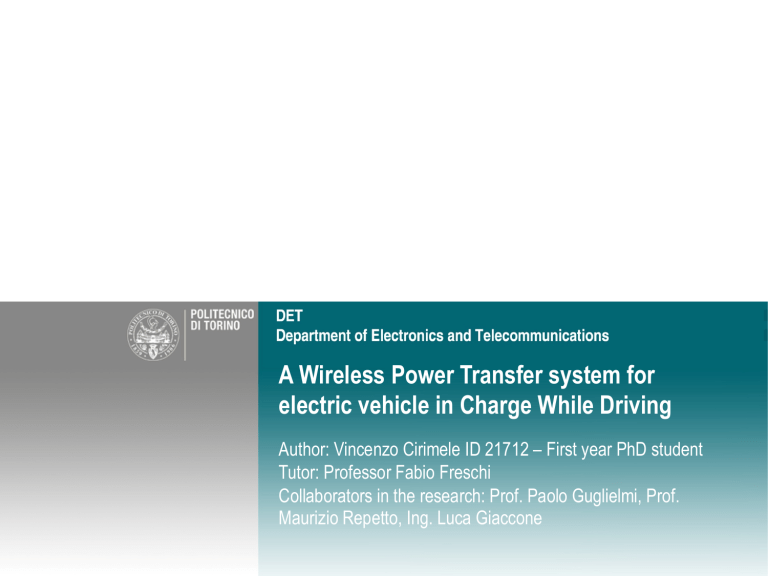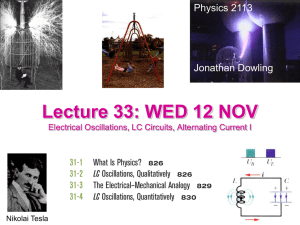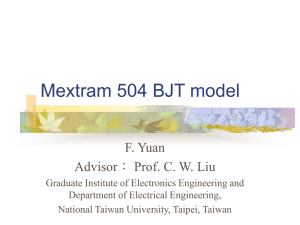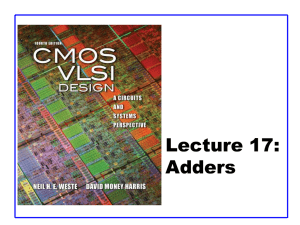A Wireless Power Transfer system for electric vehicle in Charge

A Wireless Power Transfer system for electric vehicle in Charge While Driving
Author: Vincenzo Cirimele ID 21712 – First year PhD student
Tutor: Professor Fabio Freschi
Collaborators in the research: Prof. Paolo Guglielmi, Prof.
Maurizio Repetto, Ing. Luca Giaccone
Attended classes
Course !
Metodi di ottimizzazione per problemi ingegneristici "
Valutazione di impatto ambientale di campi magnetici ed elettrici a frequenza industriale "
Corso breve “Electromagnetic Compatibility (EMC) for
Engineers – Scuola Nazionale Dottorandi di Elettrotecnica
“Ferdinando Gasparini” "
EPS-SIF International School on Energy
COURSE II “Energy: basic concepts and forefront ideas” "
Propulsione di veicoli elettrici e ibridi (Second level) "
Programmazione in LabView: parte 1 e parte 2 "
Sistemi elettronici di potenza per la generazione distribuita dell’energia elettrica "
Aspetti fisico-matematici dell’elettromagnetismo "
CFU !
6 "
4 "
1 "
6 "
8 "
8 "
4 "
4 "
Date !
03/06/2014 "
10/06/2014 "
18/06/2014 "
17/07/2014 "
19/09/2014 "
22/09/2014 "
Not yet registered "
Ongoing "
Wireless Power Transfer system for electric vehicle in Charge While Driving
December 4th 2014 "
2 "
Research context and motivation
Electric vehicle market is shyly growing up in these years, but there are several factors that are preventing its expansion related to technological and psychological aspects that influence the common perception about electric vehicles for private transport. "
On the other way, electric mobility is considered a good technology to
" reduce dependence on fossil fuels and resulting greenhouse gas emissions.
"
The main critical object is represented by batteries: high costs, high volumes, low power density compared with classic fossil fuels, necessity of frequent stops and long time for the recharge and not well predictable behavior during the travel, are the principal obstacles to the customer approval. "
"
My research activity is focused on the development of a Dynamic
Inductive Power Transfer system able to transfer energy to the battery of the vehicle during the motion, allowing the reduction of on-board battery capacity and the reduction of stops for the battery recharge. "
"
Differently from developed solutions based on the public transports sector and fixed tracks, my research is oriented towards the private transport.
This activity is seeing the cooperation with several universities, research centers and manufacturers and could provide important indications about the possibility to realize new concepts of road and city infrastructures addressed to the development of a full electric mobility.
"
Wireless Power Transfer system for electric vehicle in Charge While Driving
December 4th 2014 "
3 "
Addressed research questions/problems
The Wireless Power Transfer is based on an inductive coupling between a transmitting coil (fixed) and a receiving coil (mobile) usually capacitive compensated. For this reason these systems are resonant .
"
This research activity is oriented to solve and improve the following aspects: "
• individuation of proper circuit topologies for the compensation and the matching with !
power electronics structure; "
• analysis of the rules that govern the system and allow its control ; "
• design of the magnetic structure considering aspects related to the mechanical "
integration (on board and on vehicle), electromagnetic compatibility and protection of "
people against the magnetic field exposure.
"
Wireless Power Transfer system for electric vehicle in Charge While Driving
December 4th 2014 "
4 "
Novel contributions
Here a brief list of principal issues in which there was a novel contribution: "
• " Introduction of a new topology for the compensation of the primary side called “hybrid” which enables decoupling the two aspects of magnetic design and impedance matching with the power electronic supply (ref. [2]).
"
• " Development of precise rules for down-scaling of the inductive power transfer structures for constant frequency (ref.
[2]).
"
• " Formulation of an algorithm for the design of the magnetic structure using standard compensation topologies in presence of a constant voltage power electronic supply.
"
• " Building of a down-scale prototype for testing of models, circuital arrangements and control techniques with overall efficiency of 86% @100 W "
• " Study of a novel structure for the improvement of the coupling and the tolerance against misalignment according with limit for human exposure dictated by ICNIRP (ref. [3],[4]).
"
• " Development of a protocol for the management of the power electronics during the operation of wireless power transfer in charge while driving (ref. [4]). Developed within the eCo-FEV project FP7 314411 of 7 th Framework
Programme for Research of European Union. "
• " Development of a 20 kW prototype and contribution in the development of a test site in which to test future developed functionalities of the charge while driving (ref. [4]). Developed within the eCo-FEV project FP7 314411 of
7 th Framework Programme for Research of European Union. "
• " Design of a new kind of PCB capacitor for compensation in constant voltage structure. Developed inside the
FABRIC project FP7 605405 of 7 th Framework Programme for Research of European Union. "
In the next slides only a few of these points are going to be explained in detail according to the limited space of the presentation.
"
Wireless Power Transfer system for electric vehicle in Charge While Driving
December 4th 2014 "
5 "
Novel contributions: design algorithm for the magnetic structure
P battery !
I battery !
V dc link !
I DC/AC (I
1
) !
Frequency !
J1, J2 !
-> S1, S2 !
Geometry !
VSI inverter system !
END "
Optimization !
algorithm !
V
1
= rms value of 1 st " harmonic of square wave
"
A key point of the proposed solution is a imposed high voltage power transmission with relative low value of current at the inverter output differently from previous works designed with an imposed constant current whose value is chosen as the main design parameter. "
The design of the magnetic structure has to face with the impedance matching respect to the power electronics.
"
Wireless Power Transfer system for electric vehicle in Charge While Driving
December 4th 2014 "
6 "
Novel contributions: optimization process and prototype construction
Problem variables = 13 "
Objectives : "
• maximize coupling (k) "
• minimize power losses in the shields "
"
Obj. function : " min((1-k) + Ploss/Pmax) "
Differential Evolutionary Strategy optimization algorithm "
Taking into account problems of EMC and
ICNIRP limit for human exposure @100 kHz
(B max
= 27µT) "
Shielding
!
Wireless Power Transfer system for electric vehicle in Charge While Driving
December 4th 2014 "
7 "
Novel contributions: prototype and test site developing
A dedicated power plant was designed using a stabilized DC distribution line to supply more charging zones composed by six transmitting coils.
"
Receiving " structure "
Transmitting coils " On-road supply and communication "
Wireless Power Transfer system for electric vehicle in Charge While Driving
December 4th 2014 "
8 "
Novel contributions: prototype data
DC/AC converter (transmitter supply) !
Parameter " Value "
Rated power " 20 kW "
Rated DC link voltage level " 650 V "
Rated output current " 34 A "
Rated switching frequency " 100 kHz "
Frequency range (regulation) " 20 -200 kHz "
Efficiency "
(10%-100% rated load) "
97% "
Transmitting section !
Parameter " Value "
Number of transmitting coils " 6 "
Length of single coil "
Width of the single coil "
1.5 m "
0.5 m "
Receiving section !
Parameter "
Rated air gap "
Rated coupling "
Rated current "
Value "
20 cm " k = 0.15
"
66 A "
Expected efficiency of the overall system > 85% !
Wireless Power Transfer system for electric vehicle in Charge While Driving
December 4th 2014 "
9 "
Novel contributions: design of a PCB capacitor for MV
Capacitor data !
Parameter "
Rated capacitance "
Value "
7 nF "
Max peak voltage "
Rated current "
10 kV
40 A "
"
Proper resonance frequency " 400 MHz "
Series resonant system causes high electrical stresses over the capacitor.
In particular, series resonance, for high frequency, is related to a huge voltage drop over the capacitor.
"
Common commercial capacitors (ex. inductive welding) are not able to tolerate medium-voltage stresses so this means to use a series-parallel combination of more capacitors.
"
The designed capacitor allows to sustain very high voltage using a single component for each coil through t h e u s e o f a m u l t i - l a y e r P C B technology.
"
Wireless Power Transfer system for electric vehicle in Charge While Driving
December 4th 2014 "
10 "
Adopted methodologies: mutual coupled inductors, reflected impedance and total impedance
Coupling coefficient "
Equivalent resistance "
Time-domain "
Frequency-domain "
Extracting the current I
2
from the second equation and substituting it in the first one, it is possible to find the equivalent impedance seen by the source called total impedance (Z
T
). The part related to the receiving side is called reflected impedance (Z
R
) !
V
1
I
1
= ( R
1
+ j !
L
1
) +
!
2 M 2
R
2
+ j !
L
2
+ R
L
= Z
T
Wireless Power Transfer system for electric vehicle in Charge While Driving
December 4th 2014 "
11 "
Adopted methodologies: pros of resonance on both sides
•
On the receiving side:
maximize power transfer capability "
P
2
/ V oc
I
2
= V oc q
R 2
L
V oc
+ ( !
L
2
)
2
• On the transmitting side:
minimize the VA rating of the converter (cost ) "
• On the efficiency side: "
adopt a resonant converter and have the possibility to "
reduce ideally to zero the switching losses (ZCS/ZVS ) "
Model of the receiving side "
S
1
> P
1
≈
P
2 "
Additional info (title, place,...) "
S
1
= P
1
≈
P
2 "
12 "
Adopted methodologies: frequency response and control
Constant coupling k = 0.1
"
R
L
= 0.1 Ω
R
L
= 100 Ω
R
L
= 20 Ω
Differently from single resonant circuits, the coupling of two resonant circuits introduces the presence of two minima in the total impedance value that vary in magnitude and frequency depending on the coupling but also on the value of the load. This aspect is critical for the control of the power electronics and the possibility of regulation through the variation of frequency.
"
Additional info (title, place,...) " 13 "
Submitted and published conference/journal papers
[1] Davide Bavastro, Aldo Canova, Vincenzo Cirimele, Fabio Freschi, Luca Giaccone, Paolo
Guglielmi, Maurizio Repetto, “Design of Wireless Power Transmission for a Charge While Driving
System”, IEEE Transaction on Magnetics, vol. 50 n. 2, pp. 965-968, February 2014.
[2] Vincenzo Cirimele, Fabio Freschi, Paolo Guglielmi, “Wireless Power Transfer Structure Design for
Electric Vehicle in Charge While Driving”, Proceedings of XXI th International Conference on
Electrical Machines (ICEM 2014), September 2-5 2014, Berlin.
[3] Vincenzo Cirimele, Fabio Freschi, “Design of a magnetic structure for inductive power transfer for electric vehicle charge during the motion”, Short paper proceedings of 13 th International Workshop on 1&2 Dimensional Magnetic Measurement and Testing (2dm), September 10-12 2014, Turin.
[4] Vincenzo Cirimele, Michela Diana, Nadim El Sayed, Fabio Freschi, Paolo Guglielmi, Giovanni
Piccoli, “An innovative next generation E-mobility infrastructure: the eCo-FEV project”, IEEE
International Electric Vehicle Conference (IEVC 2014), December 17-19 2014, Florence
[5] Vincenzo Cirimele, Michela Diana, Paolo Guglielmi, Giovanni Piccoli, “Multi-n-phase Electric
Drivers for traction Applications”, IEEE International Electric Vehicle Conference (IEVC 2014),
December 17-19 2014, Florence
Wireless Power Transfer system for electric vehicle in Charge While Driving
December 4th 2014 "
14 "
Future work
Research efforts will be oriented in the direction of the research of the control techniques for the optimization of the power electronic operations in order to obtain an efficient transmission and the capability to quickly react against the possible faults that could occur during the recharge process.
"
To provide this analysis, a laboratory prototype is under construction.
"
It will be used also for the testing of shielding solution and the behavior of the new designed components. "
Wireless Power Transfer system for electric vehicle in Charge While Driving
December 4th 2014 "
15 "



